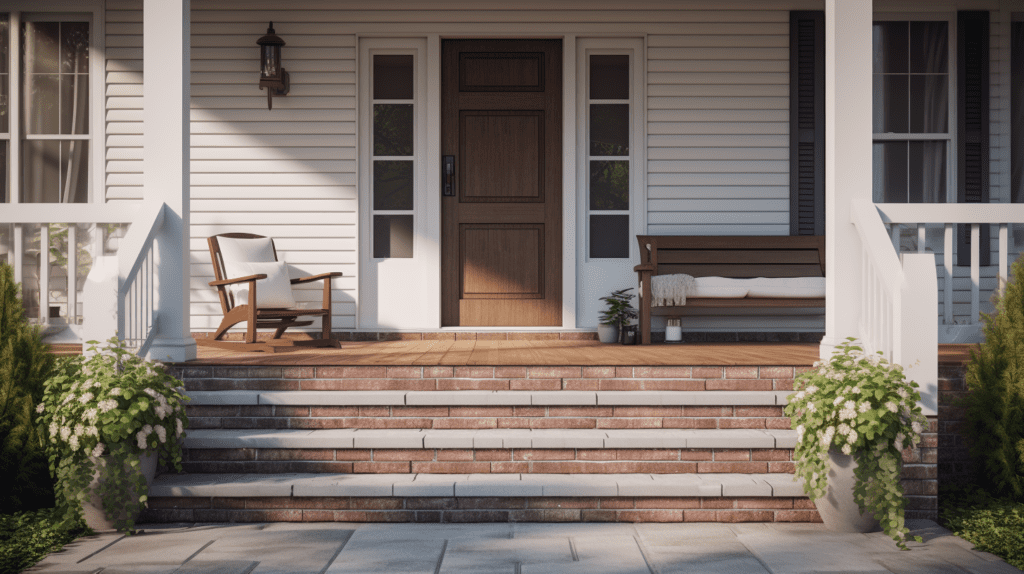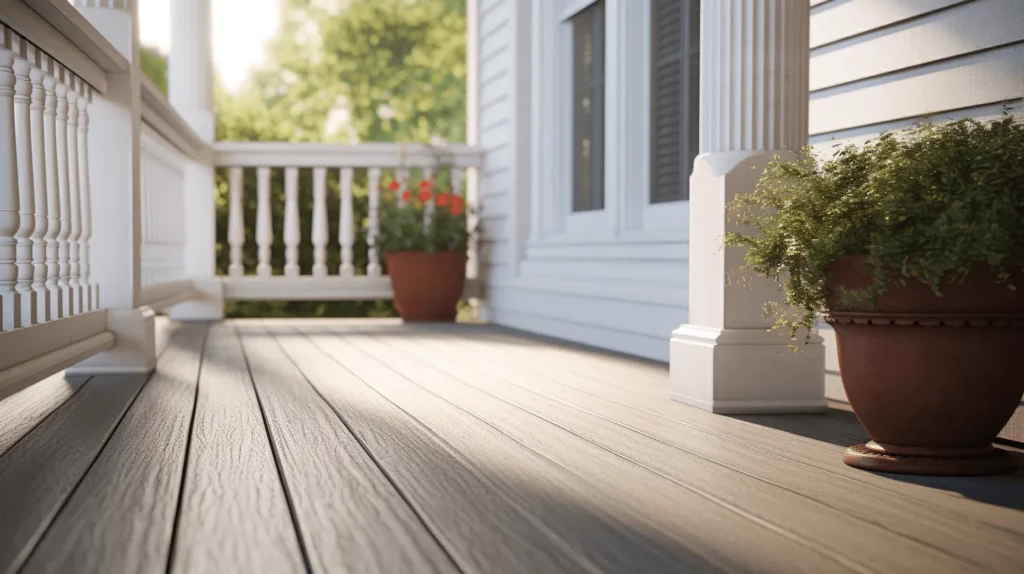If you’re planning to build a porch, deciding on whether to use 4×4 or 6×6 posts for porch roof, may be on your mind. If you’ve found yourself faced with the decision of whether to use one or the other to support it, we can help you decide. This may seem like a minor detail, but it’s a decision that can have a significant impact on the stability and aesthetics of your porch. In this article, we’ll delve into the factors that should guide your choice between these two post sizes, ensuring that your porch roof stands strong and looks great.
Understanding the Basics
Contents
- 1 Understanding the Basics
- 2 Strength and Stability
- 3 Aesthetics and Design
- 4 Cost Considerations
- 5 Installation and Building Codes
- 6 Final Thoughts About 4×4 Or 6×6 Posts For Porch Roof
- 7 FAQs (Frequently Asked Questions)
- 7.1 Can I use 4×4 posts for a large porch roof if I reinforce them?
- 7.2 Do 6×6 posts require more maintenance than 4×4 posts?
- 7.3 Are there any alternatives to wood posts for porch roofs?
- 7.4 Can I mix 4×4 and 6×6 posts on the same porch for design variety?
- 7.5 What’s the average lifespan of wood posts for porch roofs?
Before we delve into the specifics of choosing between 4×4 and 6×6 posts for your porch roof, let’s take a moment to grasp the fundamentals. When we refer to 4×4 and 6×6 posts, we’re essentially talking about the dimensions of these vital porch components, measured in inches.
A 4×4 post measures four inches by four inches, while a 6×6 post measures a more substantial six inches by six inches. On the surface, this disparity in size might not appear significant, but when it comes to porch construction, it can truly make all the difference.
Strength and Stability
When it comes to the vital components of your porch roof, strength and stability are paramount. The choice between 4×4 and 6×6 posts is directly linked to how robust and secure your porch roof will be.
Understanding the Strength Differential
First and foremost, it’s essential to grasp that 6×6 posts inherently possess a greater degree of strength compared to their 4×4 counterparts. The discrepancy in size plays a pivotal role here – a larger post translates to increased load-bearing capacity and resilience.
Handling Heavy Loads with Ease
Imagine your porch roof during a heavy snowfall or a bout of severe weather. In such scenarios, the weight and pressure on the roof can be substantial. This is where the disparity in post sizes becomes truly apparent. 6×6 posts are designed to handle these heavy loads with greater ease and efficiency. They offer the robustness needed to ensure your porch remains steadfast and secure, even under the most challenging conditions.
Guarding Against Swaying and Bending
A porch roof isn’t merely static; it must withstand various forces, including wind and dynamic loads. Here, 6×6 posts shine once again. Their larger dimensions provide superior resistance to swaying and bending, ensuring that your porch remains stable and unyielding, regardless of external pressures.
Tailoring the Choice to Your Porch’s Size
While 6×6 posts undeniably offer impressive strength and stability benefits, the choice isn’t solely based on post size. It’s also about aligning your choice with the specific characteristics of your porch. If your porch is relatively modest in size and won’t be exposed to heavy snow accumulations or high winds, 4×4 posts may well suffice. However, for larger porches or those situated in regions prone to extreme weather conditions, 6×6 posts are the unequivocally safer choice. They provide a robust foundation that guarantees the structural integrity of your porch roof.
Aesthetics and Design
While the structural strength of your porch is undoubtedly a crucial consideration, aesthetics and design should not be underestimated. The choice between 4×4 and 6×6 posts isn’t just about function; it’s also about fashioning the ideal visual appeal for your porch.
The Visual Impact of Post Size
First and foremost, let’s acknowledge that the size of your porch posts can dramatically influence the aesthetics of your entire outdoor space. When you opt for 6×6 posts, you’re essentially introducing a more substantial and imposing element to your porch’s design. These larger posts command attention and exude a sense of solidity, giving your porch a bolder and more prominent appearance.
In contrast, 4×4 posts offer a different aesthetic sensibility. Their dimensions are more delicate and streamlined, contributing to a lighter and less visually dominating presence. This choice imparts a sense of simplicity and elegance to your porch’s design.
Harmonizing with Your Design Vision
Selecting the appropriate post size should be a thoughtful endeavor that aligns with your design preferences and the architectural style of your home. Consider the broader context of your porch’s design – from its roofing material and color palette to the railing and flooring choices. Each of these elements should harmonize cohesively to create a well-balanced and visually pleasing outdoor space.
Take into account how the posts will integrate with the rest of your porch. Will they complement the existing architectural features of your home, such as its siding or facade? Are you aiming for a traditional, rustic, or contemporary look? These are questions that should guide your decision-making process.
Balancing Form and Function
While aesthetics are essential, it’s equally crucial to strike a balance between form and function. Your chosen post size should not only enhance the visual appeal of your porch but also align with its intended use. For example, if your porch serves as a cozy spot for relaxation and outdoor gatherings, a more substantial 6×6 post might contribute to the sense of security and comfort.
In contrast, if your porch is a space where you seek a minimalist and unobtrusive design, 4×4 posts can fulfill this aesthetic vision while providing adequate support.
Cost Considerations
As you embark on the journey of choosing between 4×4 and 6×6 posts for your porch, an essential aspect to weigh is the cost. It’s no secret that your budget plays a pivotal role in making this decision. Generally, 4×4 posts hold an advantage in the affordability department compared to their more massive 6×6 counterparts. However, this cost disparity is not the sole factor to consider; it’s about striking a harmonious balance between budget constraints and the structural demands of your porch.
The Appeal of Cost Savings
Let’s begin with the undeniable allure of cost savings. In many cases, opting for 4×4 posts can be a more budget-friendly choice. These smaller posts typically come with a lower price tag, making them an attractive option for homeowners mindful of their expenditures. If your project budget is relatively tight, the cost advantage of 4×4 posts may indeed influence your decision.
The Structural Equation
However, it’s imperative to recognize that cost savings should not come at the expense of structural integrity. Porch roofs, even those covering smaller spaces, must meet specific load-bearing requirements to ensure safety and durability. While 4×4 posts can adequately support some porch roofs, there are limitations to consider, especially for larger or more demanding installations.
For instance, if your porch roof is expansive or situated in an area prone to severe weather conditions, opting for 6×6 posts may be a wise investment in the long-term stability and safety of your structure. Choosing 4×4 posts solely based on budget considerations could potentially compromise the integrity of your porch, leading to costly repairs or replacements down the line.
The Balance of Budget and Quality
The key takeaway here is that cost considerations should be balanced with the overall quality and longevity of your porch. While 4×4 posts can offer immediate budget relief, it’s essential to evaluate the long-term cost implications. Will you need to invest in additional structural reinforcements or frequent maintenance to compensate for the reduced load-bearing capacity of smaller posts? These factors can contribute to hidden expenses over time.
Conversely, 6×6 posts may require a more substantial upfront investment, but they offer greater peace of mind in terms of stability and long-lasting performance. By making an informed decision that aligns with your budget and porch requirements, you ensure that your porch not only stays within financial boundaries but also stands strong for years to come.
Installation and Building Codes
As you navigate the intricate path of choosing between 4×4 and 6×6 posts for your porch, you’re about to embark on one of the most critical phases of your decision-making journey. This phase involves adhering to local building codes and regulations, a vital consideration that can profoundly impact your porch construction project. Building codes are not mere suggestions; they are legal requirements that carry significant implications if not followed diligently.
The Backbone of Safety
Building codes serve as the backbone of safety and structural integrity in construction projects. They are meticulously crafted to ensure that every aspect of your porch, from its foundation to its roofing, meets specific safety standards. This includes requirements related to post size, load-bearing capacity, and overall structural soundness.
Tailoring Post Size to Code Requirements
One of the primary aspects covered by building codes is the minimum post size based on factors such as porch size and the anticipated roof load. These codes are designed to guarantee that your porch can withstand the forces it will encounter throughout its lifespan. Failure to adhere to these codes can result in legal repercussions and, more importantly, safety hazards.
Consultation with Professionals
To navigate the complex terrain of building codes effectively, it’s highly advisable to consult with a building professional or inspector. These experts possess the knowledge and experience needed to interpret local codes accurately and apply them to your specific porch design. Their insights can be invaluable in guiding your decision-making process.
Legal and Safety Implications
Failing to comply with building codes can lead to a myriad of legal and safety concerns. You may encounter challenges when obtaining permits for your project, and in the worst-case scenario, your porch may be deemed unsafe, requiring costly modifications or even demolition and reconstruction.
Moreover, if your porch does not meet code requirements, it could jeopardize the safety of those who use it. This includes your family, friends, and any visitors who enjoy your outdoor space. Safety should always be a top priority in construction, and adherence to building codes is a fundamental step in achieving this goal.
Final Thoughts About 4×4 Or 6×6 Posts For Porch Roof
In the debate between 4×4 and 6×6 posts for porch roof, there is no one-size-fits-all answer. The choice depends on various factors, including the size of your porch, your aesthetic preferences, budget constraints, and local building codes. It’s vital to carefully consider these factors to make an informed decision that ensures the safety, stability, and visual appeal of your porch.
FAQs (Frequently Asked Questions)
Can I use 4×4 posts for a large porch roof if I reinforce them?
While reinforcing 4×4 posts can increase their load-bearing capacity, it’s generally recommended to use 6×6 posts for larger porch roofs to ensure structural integrity.
Do 6×6 posts require more maintenance than 4×4 posts?
Both 4×4 and 6×6 posts made from treated lumber are relatively low-maintenance. Regular inspections and occasional sealing or painting can help extend their lifespan.
Are there any alternatives to wood posts for porch roofs?
Yes, steel or aluminum posts are alternatives to wood. They offer excellent strength and durability but may have different aesthetic considerations.
Can I mix 4×4 and 6×6 posts on the same porch for design variety?
Mixing post sizes can be an interesting design choice, but it should be done carefully to maintain structural integrity and aesthetics.
What’s the average lifespan of wood posts for porch roofs?
The lifespan of wood posts depends on factors like the type of wood, maintenance, and exposure to the elements. With proper care, they can last 20 years or more.




